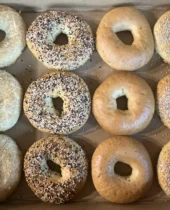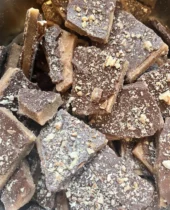Bubbly Crispy Focaccia
Golden, airy, bakery-quality focaccia—no stress, no sourdough starter, just time and olive oil.
This focaccia is everything we love about great bread: a crackly crust, an open crumb, and that rich, savory depth you usually only find at your favorite bakery. The secret? Time does the heavy lifting. A slow, cold fermentation creates gorgeous bubbles and big flavor—no kneading, no complicated shaping. Just stretch, rest, bake, and devour.
Serve it as a side, use it for sandwiches, or tear off warm chunks to dip in olive oil. However you enjoy it, this is focaccia made easy—and made to impress.
“Golden, crisp-edged, and full of flavor—this focaccia is bakery-quality bread made in your own kitchen.”
Why You’ll Love It
Crispy & Chewy: That signature contrast—crunchy edges with a soft, airy middle.
Deep Flavor: A 24-hour rest in the fridge builds complexity you can taste in every bite.
Flexible & Forgiving: No stand mixer or shaping skills needed.
Versatile: Serve it with soups, slice it for sandwiches, or snack on it solo.
Ingredients & Substitutions
| INGREDIENT | WHY IT MATTERS | SUBSTITUTIONS/NOTES |
|---|---|---|
| Bread Flour | High protein = chewy texture | All-purpose works, but with a softer structure and smaller bubbles |
| Water (warm) | Hydrates flour, activates yeast | Around 100°F (38°C) is ideal |
| Salt | Balances flavor and strengthens dough | Don’t skimp—it’s key to the final flavor |
| Olive Oil | Adds richness and helps crisp the crust | Extra virgin for best flavor |
| Active Dry Yeast | Lifts the dough slowly and evenly | Instant yeast works—use slightly less |
The Beauty of Cold-Fermented Focaccia
Bread making can feel like a lot. But this one? It’s mostly hands-off. You mix and let the fridge do the magic. Long fermentation = complex flavor and those classic air bubbles. It’s a technique that sounds fancy—but feels surprisingly chill.
Do I need to use the Stretch and Fold Technique?
The short answer is No.
Stretch and Fold is a gentle way to strengthen your dough—without kneading.
Instead of pressing and working the dough hard (like traditional kneading), you lift, stretch, and fold it over itself. This builds structure while keeping the dough soft and airy—perfect for bubbly breads like focaccia. (For more information, check out this blog post here)
As long as you are using a high-protein flour such as bread flour, the moment water is incorporated, the gluten is going to start forming naturally as it rests in the fridge.
Stretch and folds are great to use if you need the dough to have strength to shape bread into a boule or loaf, but since focaccia bakes in a pan, we don’t need to develop as much strength in our dough.
Frequently Asked Questions (FAQ)
Can I use all-purpose flour instead of bread flour?
Yes, but expect slightly less chew and fewer bubbles. It will still be delicious!
Why refrigerate the dough overnight?
Cold fermentation builds complex flavor and allows more bubbles to form for a better texture.
Can I bake this the same day?
Technically yes, but you’ll miss out on the flavor and structure that comes from resting the dough overnight.
What if my dough feels too wet or sticky?
That’s normal! Focaccia dough is meant to be sticky. Resist the urge to add flour—trust the process.
Bubbly Crispy Focaccia
Prep Time: 24 hours
Cook Time: 30 minutes
Total Time: 24 hours 30 minutes
Servings: 16 Servings
Equipment
Mixing Bowl
Rubber Spatula
9×13 Baking Pan
Plastic Wrap
Measuring Cups and Spoons or Scale
Ingredients
4 Cups (560g) Bread Flour
2 Cups (480g) Water
2 Teaspoon (10g) Salt
1 Tablespoon (20g) Olive Oil
2 ¼ (7g) Active Dry Yeast
Step 1: Activate the Yeast
- – In a small bowl, combine the warm water and active dry yeast. Stir gently to dissolve. Let it sit for about 5-10 minutes until the mixture becomes bubbly and frothy, indicating that the yeast is active.
Step 2: Prepare the Dough
- – In a large mixing bowl, combine the bread flour and salt.
- – Add the activated yeast mixture and olive oil to the flour mixture.
- – Stir using a rubber spatula or your hands until the dough begins to come together into a sticky ball.
Step 3: Rest in the Fridge
- – Cover the dough and let the it rise in the fridge for 12-24 hours. This slow fermentation will develop the flavor and texture of the focaccia, creating its signature bubbly, airy texture.
Step 4: Distribute the Gas
- – After 24 hours, remove the dough from the refrigerator and allow it to come to room temperature for 30 minutes.
- – Turn the dough over and allow gravity to remove it from the bowl and onto a greased counter.
- – Using the tips of your fingers, stretch the down on the counter out into a large rectangle, about 16×12 inches
- – Starting with the left side, fold one end of the dough one-third of the way over the top. Repeat with the other side.
- – Fold the top of the dough over one-third of the way and again repeat with the bottom. you should have a smaller rectangle packet of dough.
Step 5: Shape the Focaccia
- – Grease a 9×13-inch baking pan with olive oil.
- – Gently transfer the dough into the pan. Let it rest for 30 minutes loosely covered.
- – Gently stretch the dough to reach the corners of the pan. Trying starting the in the middle and working out to keep the dough evenly distributed.
- – Cover it loosely with plastic wrap and let it rest for about 60 minutes to allow it to puff up slightly.
Step 7: Preheat the Oven
- – Preheat the oven to 475 degrees F about 30 minutes before baking to ensure the oven gets nice and hot.
Step 8: Add the Dimpled Surface
- – After the dough has rested and risen, drizzle a bit more olive oil over the top of the dough and use your fingertips to gently press into the dough, creating small dimples all over the surface. This step helps the focaccia maintain its signature bubbly texture.
Step 9: Bake the Focaccia
- – Bake in the preheated oven for 10 minutes. Drop the oven temperature down to 350 and bake for an additional 25 minutes or until the top is golden brown and the focaccia sounds hollow when tapped on the bottom.
Step 10: Cool and Serve
- – Remove from the oven and allow the focaccia to cool completely out of the pan for a crispy bottom crust before slicing into 16 pieces.
- – Serve warm or at room temperature. Enjoy with additional olive oil for dipping or as an accompaniment to your favorite meals.
Simple Baker’s Tips
Use Good Olive Oil: It’s a major flavor player here—don’t skimp.
Top It Up: Add rosemary, flaky salt, or halved cherry tomatoes before baking.
Trust the Time: That 24-hour ferment gives focaccia its iconic bubbles and depth.
Storage: Keeps well at room temp for 2 days. Freeze slices for longer storage.
Reheat Like a Pro: Warm leftovers in the oven to revive that crisp bottom.
Final Thoughts From My Kitchen to Yours 💛
Focaccia is one of those breads that feels fancy but doesn’t ask much from you. With a little patience and a good glug of olive oil, you’ll get something golden, bubbly, and truly satisfying—no sourdough starter or bakery oven required.
So take your time, let it bubble, and enjoy the moment when that first warm slice comes out of the pan. Bread doesn’t have to be hard. It just has to be good.

